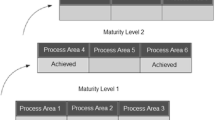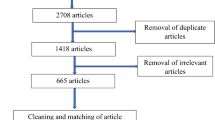Abstract
In recent years, many disciplines have begun to adopt more systematic and standardized approaches to evaluate the impact and development of a research area with a stronger emphasis on quantitative techniques. In particular, identifying and analyzing the published literature have become important exercises for many disciplines and methods such as systematic literature review and bibliometric analysis have become more regularly used to obtain a deeper understanding of a research area. One concept that is of particular interest is the maturity, or level of development, of a research area. While this concept has been mentioned in many works, it has not yet been formalized, resulting in a lack of consensus concerning the definition of research area maturity and analysis techniques to assess maturity. Therefore, most assessments of research area maturity consider only a subset of the possible criteria with significant differences in the metrics and analyses used among different disciplines. Due to the inconsistencies in the definition and assessment of this concept, a comprehensive synthesis of this literature area is needed. This paper presents the results of a study to identify and analyze the literature, define the maturity of a research area, and synthesize the criteria for assessing maturity. The results are used to develop a generalized maturity assessment framework that establishes a comprehensive set of criteria, which can be adapted for use across a variety of research areas.








Similar content being viewed by others
References
Archambault, É., & Larivière, V. (2010). The limits of bibliometrics for the analysis of the social sciences and humanities literature. World Social Science Report, 251–254.
Becheikh, N. (2010). How to improve knowledge transfer strategies and practices in education? Answers from a systematic literature review. Research in Higher Education Journal, 7, 1–21.
Borenstein, M., Hedges, L. V., Higgins, J. P. T., & Rothstein, H. R. (2009). Introduction to meta-analysis. doi:10.1002/9780470743386.
Bornmann, L. (2015). Alternative metrics in scientometrics: A meta-analysis of research into three altmetrics. Scientometrics, 103(3), 1123–1144. doi:10.1007/s11192-015-1565-y.
Borrego, M., & Bernhard, J. (2011). The emergence of engineering education research as an internationally connected field of inquiry. Journal of Engineering Education, 100(1), 14–47. doi:10.1002/j.2168-9830.2011.tb00003.x.
Brookes, B. C. (1990). Biblio-, sciento-, infor-metrics? What are we talking about? In L. Egghe, & R. Rousseau (Eds.), Informetrics 89/90 (pp. 31–43). Diepenbeek.
Budi, I., Aji, R. F., & Widodo, A. (2013). Prediction of research topics on science & technology (S&T) using ensemble forecasting. International Journal of Software Engineering and Its Applications, 7(5), 253–268. doi:10.14257/ijseia.2013.7.5.23.
Campbell Resource Center. (n.d.). Retrieved January 23, 2015, from http://www.campbellcollaboration.org/resources/resource_center.php.
Carlile, P. R., & Christensen, C. M. (2004). The cycles of theory building in management research, version 5.0, Harvard Business School Working Knowledge. http://www.hbs.edu/rcscarch/pdf/05-057.pdf. Accessed 21 March 2011.
Cheon, M. J., Groven, V., & Sabherwal, R. (1993). The evolution of empirical research in IS. Information & Management, 24(3), 107–119. doi:10.1016/0378-7206(93)90060-7.
Cobo, M. J., López-Herrera, A. G., Herrera-Viedma, E., & Herrera, F. (2011). An approach for detecting, quantifying, and visualizing the evolution of a research field: A practical application to the fuzzy sets theory field. Journal of Informetrics, 5(1), 146–166. doi:10.1016/j.joi.2010.10.002.
Cooper, H., & Hedges, L. V. (2009). Research synthesis as a scientific process. In The handbook of research synthesis and meta-analysis (pp. 3–17). Retrieved from http://books.google.com/books?hl=en&lr=&id=LUGd6B9eyc4C&oi=fnd&pg=PA3&dq=RESEARCH+SYNTHESIS+AS+A+SCIENTIFIC+PROCESS&ots=5MEJyT_n6P&sig=QS5-Jcd7-Wzvo8pxzZD0ktb33SM.
Cooper, H., Hedges, L., & Valentine, J. (2009). The handbook of research synthesis and meta-analysis. Psychological Review April 2006 (Vol. 113).
Cronin, P., Ryan, F., Coughlan, M., Reid, E. R., Harris, B., Vessali, K. V., et al. (2007). Undertaking a literature review: A step-by-step approach. Computers, Environment and Urban Systems, 60(1), 1–15. doi:10.1177/107808747000500401.
Diallo, S. Y., Lynch, C. J., Gore, R., & Padilla, J. J. (2016). Identifying key papers within a journal via network centrality measures. Scientometrics, 107(3), 1–16. doi:10.1007/s11192-016-1891-8.
Drew, C. H., Pettibone, K. G., Finch, F. O., Giles, D., & Jordan, P. (2016). Automated research impact assessment: A new bibliometrics approach. Scientometrics, 106(3), 987–1005. doi:10.1007/s11192-015-1828-7.
Gagnon, R. J., & Ghosh, S. (1991). Assembly line research: Historical roots, research life cycles and future directions. Omega, 19(5), 381–399. doi:10.1016/0305-0483(91)90056-Y.
Garfield, E. (2006). Citation indexes for science. A new dimension in documentation through association of ideas. International Journal of Epidemiology, 35(5), 1123–1127. doi:10.1093/ije/dyl189.
Garfield, E. (2009). From the science of science to scientometrics visualizing the history of science with HistCite software. Journal of Informetrics, 3(3), 173–179.
Grover, V. (2012). The information systems field: Making a case for maturity and contribution. Journal of the Association for Information Systems, 13(Special Issue), 254–272.
Harvey, L. J., & Myers, M. D. (1995). Scholarship and practice: The contribution of ethnographic research methods to bridging the gap. Information Technology & People, 8(3), 13–27. doi:10.1108/09593849510098244.
Hicks, D. (1999). The difficulty of achieving full coverage of international social science literature and the bibliometric consequences. Scientometrics, 44(2), 193–215.
Higgins, J., & Green, S. (Eds.). (2011). Chapter 4: Guide to the contents of a Cochrane protocol and review. Cochrane handbook for systematic reviews of interventions. The Cochrane Collaboration. doi:10.1002/9780470712184.
Hood, W. W., & Wilson, C. S. (2001). The literature of bibliometrics and informetrics scientometrics. Scientometrics, 52(2), 291–314.
Houy, C., Fettke, P., & Loos, P. (2010). Empirical research in business process management—Analysis of an emerging field of research. Business Process Management Journal, 16(4), 619–661. doi:10.1108/14637151011065946.
Karuga, G., Lowry, P., & Richardson, V. (2007). Assessing the impact of premier information systems research over time. Communications of the Association for Information Systems, 19, 115–131. Retrieved from http://aisel.aisnet.org/cgi/viewcontent.cgi?article=2650&context=cais.
Keathley, H., Bean, A., Chen, T., Vila, K., Ye, K., & Gonzalez-Aleu, F. (2015). Bibliometric analysis of author collaboration in engineering management research. In Proceedings of the 2015 international annual conference, American Society for Engineering Management, October 7-10, 2015.
Keathley, H., Bean, A., Chen, T., Vila, K., Ye, K., & Gonzalez-Aleu, F. (2016). Bibliometric analysis of research design characteristics in engineering management research. In Proceedings of the 2016 industrial and systems engineering research conference, Institute of Industrial Engineers, May 21-24, 2016.
Li, X., Hu, D., Dang, Y., Chen, H., Roco, M. C., Larson, C. A., et al. (2009). Nano Mapper: An Internet knowledge mapping system for nanotechnology development. Journal of Nanoparticle Research, 11(3), 529–552. doi:10.1007/s11051-008-9491-z.
Lim, J., Rong, G., & Grover, V. (2007). An inductive approach to documenting the “core” and evolution of the IS field. Communications of the Association for Information Systems, 19(32), 665–691. Retrieved from http://aisel.aisnet.org/cgi/viewcontent.cgi?article=2675&context=cais.
Maloni, M. J., Carter, C. R., & Carr, A. S. (2009). Assessing logistics maturation through author concentration. International Journal of Physical Distribution & Logistics Management, 39(3), 250–268. doi:10.1108/09600030910951728.
Maloni, M., Carter, C. R., & Kaufmann, L. (2012). Author affiliation in supply chain management and logistics journals: 2008–2010. International Journal of Physical Distribution & Logistics Management,. doi:10.1108/09600031211202481.
Mongeon, P., & Paul-Hus, A. (2016). The journal coverage of Web of Science and Scopus: A comparative analysis. Scientometrics, 106(1), 213–228. doi:10.1007/s11192-015-1765-5.
Moody, D. L. (2000). Building links between IS research and professional practice: Improving the relevance and impact of IS research. In Proceedings of the twenty first international conference on information systems (Issue 1, pp. 351–360). Retrieved from http://dl.acm.org/citation.cfm?id=359640.359760.
Neely, A. (2005). The evolution of performance measurement research: Developments in the last decade and a research agenda for the next. International Journal of Operations & Production Management, 25(12), 1264–1277. doi:10.1108/01443570510633648.
Nie, K., Ma, T., & Nakamori, Y. (2009). An approach to aid understanding emerging research fields—The case of knowledge management. Systems Research and Behavioral Science, 26(6), 629–643. doi:10.1002/sres.926.
Nissen, M. E. (1995). A focused review or the reengineering literature: Expert frequently asked questions. Quality Management Journal, 3(3), 52–66.
Pasqualine, A., Plytiuk, C. F., da Costa, S. E. G., & de Lima, E. P. (2012). Performance management in healthcare: A bibliometric review. In IIE Annual Conference. Proceedings (p. 1). Institute of Industrial Engineers-Publisher.
Patra, S. K., Bhattacharya, P., & Verma, N. (2006). Bibliometric study of literature on bibliometrics. DESIDOC Bulletin of Information Technology, 26(1), 27–32. Retrieved from http://search.ebscohost.com/login.aspx?direct=true&db=lxh&AN=23638785&site=ehost-live.
Paul-Hus, A., Desrochers, N., & Costas, R. (2016). Characterization, description, and considerations for the use of funding acknowledgement data in Web of Science. Scientometrics,. doi:10.1007/s11192-016-1953-y.
Perianes-Rodriguez, A., & Ruiz-Castillo, J. (2016). A comparison of two ways of evaluating research units working in different scientific fields. Scientometrics, 106(2), 539–561. doi:10.1007/s11192-015-1801-5.
Piro, F. N., Rørstad, K., & Aksnes, D. W. (2016). How does prolific professors influence on the citation impact of their university departments? Scientometrics, 107(3), 1–21. doi:10.1007/s11192-016-1900-y.
Porter, A. L., & Detampel, M. J. (1995). Technology opportunities analysis. Technological Forecasting and Social Change, 49(3), 237–255. doi:10.1016/0040-1625(95)00022-3.
Pritchard, A. (1969). Statistical bibliography or bibliometrics. Journal of Documentation, 25, 348.
Schmenner, R. W., Wassenhove, L. Van, Ketokivi, M., Heyl, J., & Lusch, R. F. (2009). Too much theory, not enough understanding. Journal of Operations Management, 27(5), 339–343. doi:10.1016/j.jom.2009.07.004.
Schoepflin, U., & Glänzel, W. (2001). Two decades of “Scientometrics” An interdisciplinary field represented by its leading journal. Scientometrics, 50(2), 301–312. doi:10.1023/A:1010577824449.
Small, H. (1973). Co-citation in the scientific literature: A new measure of the relationship between two documents. Journal of the American Society for Information Science, 24(4), 265–269.
Small, H. (1999). Visualizing science by citation mapping. Journal of the American Society for Information Science, 50(9), 799–813. doi:10.1002/(SICI)1097-4571(1999)50:9<799:AID-ASI9>3.0.CO;2-G.
Smith, D. R. (2012). Impact factors, scientometrics and the history of citation-based research. Scientometrics, 92(2), 419–427.
Stone, K. B. (2012). Four decades of lean: A systematic literature review. International Journal of Lean Six Sigma, 3(2), 112–132. doi:10.1108/20401461211243702.
Sud, P., & Thelwall, M. (2014). Evaluating altmetrics. Scientometrics, 98(2), 1131–1143. doi:10.1007/s11192-013-1117-2.
Sun, X., Lin, H., Xu, K., & Ding, K. (2015). How we collaborate: Characterizing, modeling and predicting scientific collaborations. Scientometrics,. doi:10.1007/s11192-015-1597-3.
Taylor, A., & Taylor, M. (2009). Operations management research: Contemporary themes, trends and potential future directions. International Journal of Operations & Production Management, 29(12), 1316–1340. doi:10.1108/01443570911006018.
Tranfield, D., Denyer, D., & Smart, P. (2003). Towards a methodology for developing evidence-informed management knowledge by means of systematic review. British Journal of Management, 14, 207–222. doi:10.1111/1467-8551.00375.
Walsh, D., & Downe, S. (2005). Meta-synthesis method for qualitative research: A literature review. Journal of Advanced Nursing,. doi:10.1111/j.1365-2648.2005.03380.x.
Wendler, R. (2012). The maturity of maturity model research: A systematic mapping study. Information and Software Technology, 54(12), 1317–1339. doi:10.1016/j.infsof.2012.07.007.
Zhao, Y., & Zhao, R. (2016). An evolutionary analysis of collaboration networks in scientometrics. Scientometrics, 107(2), 759–772. doi:10.1007/s11192-016-1857-x.
Author information
Authors and Affiliations
Corresponding author
Rights and permissions
About this article
Cite this article
Keathley-Herring, H., Van Aken, E., Gonzalez-Aleu, F. et al. Assessing the maturity of a research area: bibliometric review and proposed framework. Scientometrics 109, 927–951 (2016). https://doi.org/10.1007/s11192-016-2096-x
Received:
Published:
Issue Date:
DOI: https://doi.org/10.1007/s11192-016-2096-x




